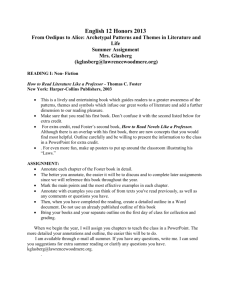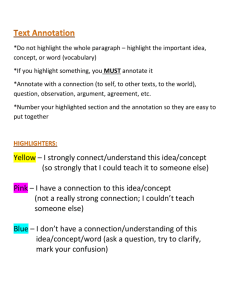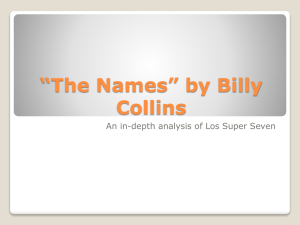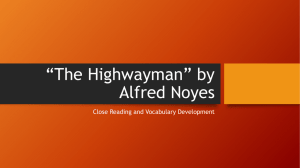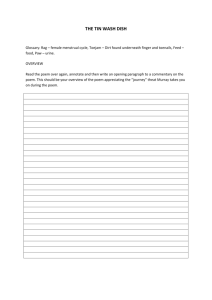File
advertisement
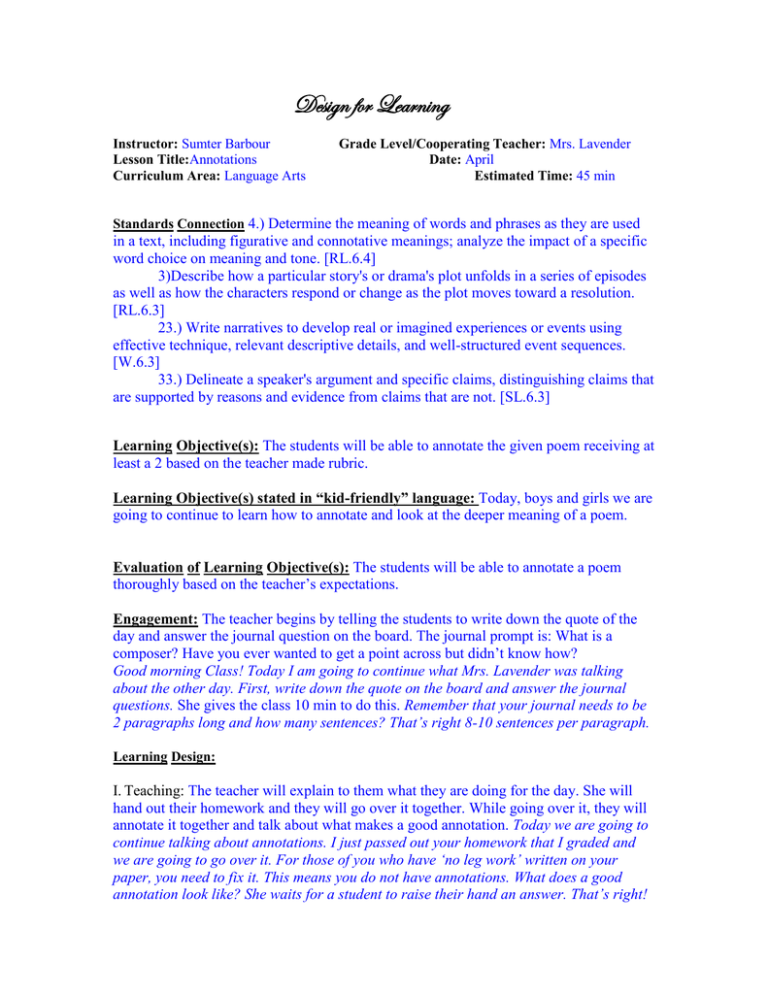
Design for Learning Instructor: Sumter Barbour Lesson Title:Annotations Curriculum Area: Language Arts Grade Level/Cooperating Teacher: Mrs. Lavender Date: April Estimated Time: 45 min Standards Connection 4.) Determine the meaning of words and phrases as they are used in a text, including figurative and connotative meanings; analyze the impact of a specific word choice on meaning and tone. [RL.6.4] 3)Describe how a particular story's or drama's plot unfolds in a series of episodes as well as how the characters respond or change as the plot moves toward a resolution. [RL.6.3] 23.) Write narratives to develop real or imagined experiences or events using effective technique, relevant descriptive details, and well-structured event sequences. [W.6.3] 33.) Delineate a speaker's argument and specific claims, distinguishing claims that are supported by reasons and evidence from claims that are not. [SL.6.3] Learning Objective(s): The students will be able to annotate the given poem receiving at least a 2 based on the teacher made rubric. Learning Objective(s) stated in “kid-friendly” language: Today, boys and girls we are going to continue to learn how to annotate and look at the deeper meaning of a poem. Evaluation of Learning Objective(s): The students will be able to annotate a poem thoroughly based on the teacher’s expectations. Engagement: The teacher begins by telling the students to write down the quote of the day and answer the journal question on the board. The journal prompt is: What is a composer? Have you ever wanted to get a point across but didn’t know how? Good morning Class! Today I am going to continue what Mrs. Lavender was talking about the other day. First, write down the quote on the board and answer the journal questions. She gives the class 10 min to do this. Remember that your journal needs to be 2 paragraphs long and how many sentences? That’s right 8-10 sentences per paragraph. Learning Design: I. Teaching: The teacher will explain to them what they are doing for the day. She will hand out their homework and they will go over it together. While going over it, they will annotate it together and talk about what makes a good annotation. Today we are going to continue talking about annotations. I just passed out your homework that I graded and we are going to go over it. For those of you who have ‘no leg work’ written on your paper, you need to fix it. This means you do not have annotations. What does a good annotation look like? She waits for a student to raise their hand an answer. That’s right! Annotations involve highlighting and underlining. We highlight and underline what is important. Someone tell me what they highlighted and why it is important. She calls on a few students. Also it involves writing explanations. Why is it a good thing to annotate a piece of writing? It is important because it helps you better understand what you read. It also allows you to comment on important details. So lets go over Daybreak in Alabama and annotate it together. The teacher projects the poem using the ELMO. Will someone read the first stanza for me? She calls on a student who reads the stanza. Can anyone tell me what they did to this stanza? Awesome! And why did you highlight it. Sometimes it is smart to highlight it and then write why next to it. While going through the poem she asks students what they think the author is talking about. Do you really think the author is a composer? What I did was write down what I think the author is trying to portray. When I read a poem and annotate it, I write down my thoughts. Why do you want to write down your thoughts? That’s right! It helps you understand what the poem or story is talking about. When you write it down, you can see what connections you made. They also talk about the poem and what it is trying to portray. What do you think the author is talking about in the second stanza? Once they go through the poem, she collects their work. Ok, pass up your papers and now its your turn to try it by yourself. II. Opportunity for Practice: The teacher will then hand out an article for the students to annotate it in groups of two. Ok, you will have 10 minutes to annotate this passage. What are we going to remember to do? That’s right! Highlight and take notes. All right you may begin! While the students are working, she walks around and makes sure they are working correctly. III. Assessment: As an assessment, the teacher will hand out another poem and ask the students to annotate it. The poem needs to have enough annotations to show the student understands what they are doing. Ok, I am going to hand out a poem and you all are going to annotate it. Remember what we talked about. Show your legwork! You will have 10 to 15 minutes to complete this. Make sure you put your name on it. IV. Closure: Once down. The teacher will review what each connection is and the definitions. How many types of connections are there? Good! There are 3 and they are text to text, text to self and text to world! Remember while you read it is important to make connections why? Because it will help us understand the text better and will help us relate to it. Materials and Resources: Poem- Romeo and Juliet Daybreak in Alabama ELMO Passage Differentiation Strategies (including plans for individual learners): Make a chart for annotations Go through a powerpoint. Hand out a teacher-made chart Data Analysis: They did all their legwork and everyone completed their poem. Daybreak in Alabama looked much better. Out of all the students only two did not have enough annotations. Reflection: This lesson went really well. There was a lot of writing so I feel like the students felt like it was redundant. I would have done a better activity if their was more time. Samford University Design for Learning Score 2 Highlights Students have more than 4 things highlighted 1 Students did not highlight or had less than 4 highlighted Underlining Students have sentences and words underlined. More than 5. Students did not underline or had less than 5 things underlined. Comments Students wrote comments out to the side-at least 4 Students did not write any comments or wrote less than 4 comments.



